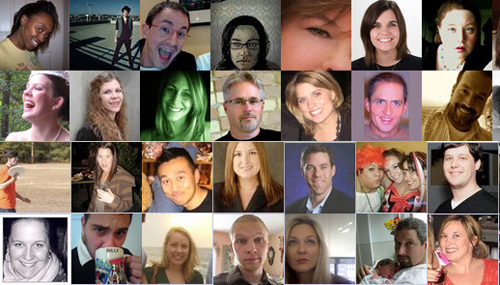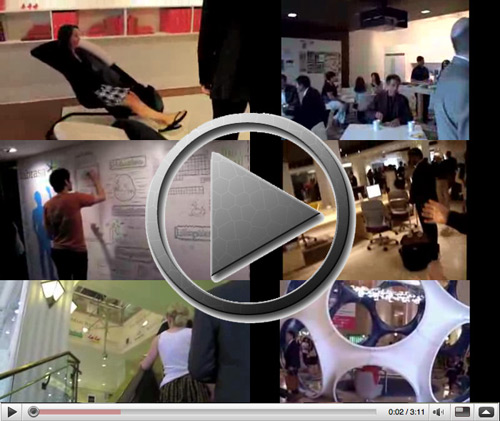This week provided another example of Twitter’s usefulness, as it became a primary communication tool to get first hand news from Iran. I have to say, I keep waiting for the Twitter hype to end, except it keeps becoming more and more useful!
Here is Clay Shirky’s take on what happened this week:
"This is the first revolution that has been catapulted onto a global stage and transformed by social media. I’ve been thinking a lot about the Chicago demonstrations of 1968 where they chanted "the whole world is watching." Really, that wasn’t true then. But this time it’s true … and people throughout the world are not only listening but responding. They’re engaging with individual participants, they’re passing on their messages to their friends, and they’re even providing detailed instructions to enable web proxies allowing Internet access that the authorities can’t immediately censor. That kind of participation is really extraordinary."
If this is how social media is affecting politics and the fate of a nation, imagine what it can do within B2B media and publishing. Earlier in the year, I wrote two articles about Twitter:
- Expand Your Brand & Career: Open a Twitter Account. Right Now.
- The ROI of Journalists and Magazines Using Twitter
Today, I want to take another look at how Twitter and other social media sites are reshaping how B2B journalists cover their industries.
In the past several weeks, I have met with almost every brand here at Reed Business Information to discuss their use of Twitter, and share some tips and ideas to help maximize its benefits, and find more efficient ways of using it with their existing resources. Here’s a snapshot of some of RBI’s brands on Twitter:
But this is just part of the story – many editors and staffers have their own Twitter accounts that they use to monitor the news in their industry and connect with their sources and readers. Another sampling:
| Brand | Name | Followers | Following | Updates |
| Building Design + Construction | Jay Schneider | 59 | 64 | 65 |
| Chain Leader | Mary Chapman | 146 | 149 | 66 |
| Chain Leader | Dave Farkas | 274 | 201 | 500 |
| Construction Equipment | Rod Sutton | 85 | 53 | 88 |
| Consulting-Specifying Engineer | Mike Ivanovich | 63 | 41 | 142 |
| Consulting-Specifying Engineer | Amara Rozgus | 28 | 32 | 52 |
| CSE & Plant Engineering | Elena Moeller-Younger | 123 | 147 | 26 |
| Control Engineering | David Greenfield | 176 | 26 | 55 |
| Converting | Mark Spaulding | 92 | 33 | 270 |
| Daily Commercial News & Journal of Commerce | Patrick McConnell | 46 | 19 | 130 |
| EDN | Brian Dipert | 123 | 0 | 185 |
| Home Accents Today | Wes Kennedy | 917 | 527 | 2339 |
| Home Accents Today | Susan Dickenson | 573 | 516 | 151 |
| Home Accents Today | Jenny Heinzen York | 867 | 836 | 281 |
| HOTELS | Adam Kirby | 792 | 496 | 464 |
| HOTELS | Derek Gale | 331 | 85 | 461 |
| HOTELS | Jeff Weinstein | 715 | 386 | 91 |
| Interior Design | Annie Block | 198 | 6 | 102 |
| Library Journal | Wilda Williams | 148 | 164 | 331 |
| Library Journal | Heather McCormack | 314 | 204 | 2262 |
| Library Journal | Josh Hadro | 242 | 175 | 613 |
| Modern Materials Handling | Tom Andel | 70 | 88 | 29 |
| Professional Builder | Paul Deffenbaugh | 158 | 48 | 45 |
| Publishers Weekly | Calvin Reid | 540 | 91 | 2255 |
| Publishers Weekly | Heidi MacDonald | 1727 | 241 | 1351 |
| Publishers Weekly | Marc Schultz | 281 | 493 | 687 |
| Restaurants & Institutions | Kelly Killian | 93 | 92 | 27 |
| Restaurants & Institutions | Kate Leahy | 294 | 186 | 363 |
| Restaurants & Institutions | Allison Perlik | 286 | 225 | 349 |
| School Library Journal | Kathy Ishizuka | 616 | 409 | 2609 |
| Semiconductor International | Aaron Hand | 85 | 44 | 29 |
| Test & Measurement World | Rick Nelson | 89 | 91 | 36 |
What’s more is that their industries are getting on Twitter: their competitors, their sources, the companies they cover, executives at small & medium sized businesses, their bloggers, and so many others. It’s happening quickly, and the value that it is bringing is surprising. Let’s take a look at an example…
Social Media Case Study: Tradeshow Coverage
To gauge social media’s affect on event coverage, I want to share with you a little case study on an event that happened this week. Interior Design magazine was covering the NeoCon tradeshow this week in Chicago. Here’s a description of NeoCon:
"At NeoCon World’s Trade Fair, discover thousands of innovative products and resources for corporate hospitality, health care, retail, government, institutional and residential interiors from more than 1,200 showrooms and exhibitors."
Interior Design had staff members at the event, coverage on their website, a custom online navigator, two Twitter accounts setup (here and here, plus one of their bloggers here.) and they produce the official show daily and directory for NeoCon.
But of course, they weren’t the only people covering the event. I focused in on NeoCon coverage on Twitter, Flickr and YouTube, and did a small analysis of everyone who used the event hash tag "#neocon09," in order to see what the full coverage looked like across various social media sites. Here’s what I found:
- 4,200+ Twitter Updates

This is just on the days of the show itself, not including pre and post event Tweets. This works out to 1500 or so Tweets per day, with more than 400 people updating. These folks were either at the event, or talking about it. Above is a montage of some of the folks talking about NeoCon on Twitter. - Hundreds of Photos

There were tons of photos linked through Twitter, via Twitpic. Check them out here. There were also more than 200 NeoCon photos on Flickr. For an event that is so much about product and style, this becomes a candy shop of ideas. - Dozens of Videos

These videos were shared on YouTube, giving you a first hand look at the event. Some were quite professional, while others were less so. Either way, each gave you an immediate sense of the people, the place, and the products on display.
Sure, some of these efforts are by other trade publications, some from manufacturers trying to show off their goods, some from PR agents, and some from fledgling designers trying to grab attention. There was even a contest at NeoCon and an effort to get attendees Tweeting to enter it.
But plenty of these Tweets, photos and videos were shared by industry insiders, regular attendees, and fans. The overall point here is that:
This content is being found on social networks not associated with a single media brand.
This content is being published more broadly to the web, and then shared and talked about in places that no single company could ever control – they can just try to be there in ways that helps their audience.
How to Integrate Social Media Into B2B Industry Coverage
Clearly, how people cover and interact with each other at an industry event is changing. Here are some tips to consider if you are getting ready to report on a conference, tradeshow or other event:
- Videos & Photos Make for Engaging Coverage

One of the many things I love about B2B is the passion that each person has for the nuances of their industry. At an event like NeoCon, the products take center stage, and they are amazing. But ensure you are capturing the personalities, the places, the stories that shape your industry.Sure, quality counts, and it is ideal to have superb photos, and professionally edited videos. However, that is not essential, and it is amazing the video quality you can get on a cheap Flip video camera, and a cell phone camera.
- We are Coming Closer to a Day Where an Industry Will Report on Itself

This is a core way that the role of reporters is shifting – everyone is now a reporter. The tools to share your experience with the world is literally in your pocket – in a mobile device. Anyone can update Twitter or Facebook from their phone, share pictures instantly, and take video with zero preparation.What’s more is that people are now more willing to not just capture this content, but actually share it. The adoption rate of folks using Facebook and Twitter is astounding – and it is inherently about these people coming out of their shell and sharing. In the past, this was the role of the few… trained journalists and media professionals. Not anymore.
And you can add into this mix the fact that manufacturers and marketers are now leveraging these tools to bypass intermediaries and connect directly with their audience and customers.
What this means is that journalists, publishers and media companies need to rethink their roles, and the value they are offering their industries.
- Filtering Information is a Much Needed Resource

For all the amazing things people are using social media for, I have to say, filtering that information in an engaging and useful way is still incredibly valuable.This week, if you searched Twitter for the hash tag #iranelection, and began reading the results, within 20 seconds, you would get a message saying 500+ new Tweets were added with the hash tag #iranelection in those past 20 seconds.
Even in my examples above from NeoCon, I had to search out this media and comb through it myself, slowly finding the best content.
On the flip side of things, I have had quite a few people tell me that they no longer use RSS, and instead rely on Twitter to find links to interesting articles. By following smart people and relying on the links they share – it becomes an intelligent filter to find the items people are talking about.
- Social Media is About Serving the Needs of Niches

Social media scales well, but I find that the real beauty of it is that it serves the needs of small niches incredibly well. On Facebook, I am amazed at how well it serves a niche I am a part of: people who went to a certain elementary school during a certain decade. I am able to find people, photos and stories from that very tiny niche.When considering your social media strategy, keep these niches in mind. Can you have multiple brand accounts on Twitter in order to serve the needs of very specific audiences you serve? If you are creating a Facebook group – are you targeting your industry broadly, or focusing in on the one subgroup who is most passionate about a key aspect of things?
Social media strategy can become very sophisticated very quickly, but can be more straightforward if you always consider the needs you are serving and work to measure what is working and what isn’t.
- Immediacy is Your Competitive Advantage

The concept of "breaking news" and "scoops" has changed in the age of 24 hour digital media. That’s a longer discussion for another time, but I will say that if an event is happening today, that is an opportunity to bring your audience into it as its happening – and to actually interact with it, instead of simply "consuming" content about it a day or two later. Consider ways that social media can enhance not just reporting, but interaction. - Get in Front of the Parade: Lead Your Industry to Social Media

Twitter, Facebook and YouTube are mainstream tools, yet people are still confused how to make it useful in their lives. Within your industry, lead the way. Find ways to make it fun, to make it easy, to make it useful. For everyone I have seen become a social media convert, there is an "ah-hah!" moment, when to changes from becoming something foreign to becoming something personal. - Move Beyond the Event

In the example above, I focused only on NeoCon coverage during the 3 days of the event itself. There was plenty of chatter on Twitter before and after the event. This is another opportunity – to engage with your audience and to find out how you can serve their needs. - Integrate Social Media Strategy into Existing Processes

Undoubtedly, using social media is a time-intensive investment. Consider how you can integrate it into existing processes. For example, getting in the habit of sharing the link to an article the minute after you post it to your website – or use Twitter in the process of identifying topics to write about, or ways to cover an event.There’s no magic bullet here, but social media offers an opportunity to connect more with those who matter most – the people within the industry you cover.
- Make it Fun

Social media should be fun – it should engage the passion of your readers and customers. If it’s not fun, then you’re not doing it right.

Dan,
Your analysis is tremendous (and probably only trumped by my own). You should know though, that there was one single brand behind the social media campaign at NeoCon, Designer Pages, the social media sponsor for the show. You can see more here:
http://www.youtube.com/watch?v=UVsBBbNVfJY&feat…
http://vimeo.com/5190445
http://neocon.designerpages.com
I'd be happy to share some of the data I've been compiling from our twitter campaign.
Dan,
Your analysis is tremendous (and probably only trumped by my own). You should know though, that there was one single brand behind the social media campaign at NeoCon, Designer Pages, the social media sponsor for the show. You can see more here:
http://www.youtube.com/watch?v=UVsBBbNVfJY&feat…
http://vimeo.com/5190445
http://neocon.designerpages.com
I'd be happy to share some of the data I've been compiling from our twitter campaign.
Avi – thanks for the info – I'm sending an email.
-Dan
Avi – thanks for the info – I'm sending an email.
-Dan
This is a really good contribution to the discussion about how to leverage social media tools within a traditional media environment. I'm a big fan of what ID has been able to do: they are using simple tools to extend and enhance the way they are driving content into the market. The BIG thing here is that you can leverage a brand — and the proprietary expertise of the staff — across different social media platforms without a)getting swamped by Google and b)getting disintermediated by Google.
Thanks for supplying so much detailed information.
Daniel – thanks for the comment, good points. Google is indeed the elephant in the room for many companies.
Have a nice evening.
-Dan
This is a really good contribution to the discussion about how to leverage social media tools within a traditional media environment. I'm a big fan of what ID has been able to do: they are using simple tools to extend and enhance the way they are driving content into the market. The BIG thing here is that you can leverage a brand — and the proprietary expertise of the staff — across different social media platforms without a)getting swamped by Google and b)getting disintermediated by Google.
Thanks for supplying so much detailed information.
Daniel – thanks for the comment, good points. Google is indeed the elephant in the room for many companies.
Have a nice evening.
-Dan
Dan,
In the niches that RB occupies, especially the construction ones, is Google the elephant in the room? Do you think they'll enter construction documentation, product, projects, or industry news search? I think the RB/McGrawHill/ and other independent media portals in A+D provide a much deeper glimpse into the vertical than any of the google efforts. Clearly, if they entered this space, that probably wouldn't be true for long, but I just don't see them having that sort of granular focus. However, my brother did recently inform me that the google Scholar (the PhD search engine – a sort of lexusnexus for professors/scientists/academics) has put at least two competitors out of business. But entering that space, given Google's research ambition makes sense to me, unless Google plans to take up massive construction projects (but honestly, haven't they already?), I don't see why they would need to scratch their own itch and create a vertical search in the construction business information niche. But we'll see, they are a tremendous company…
Dan,
In the niches that RB occupies, especially the construction ones, is Google the elephant in the room? Do you think they'll enter construction documentation, product, or new search? I think the RB/McGrawHill/ and other independent media portals in A+D provide a much deeper glimpse into the vertical than any of the google efforts. Clearly, if they entered this space, that probably wouldn't be true for long, but I just don't see them having that sort of granular focus. However, my brother did recently inform me that the google Scholar (the PhD search engine – a sort of lexusnexus for professors/scientists/academcis) has put at least two competitors out of business. But entering that space, given Google's research ambition makes sense to me, unless Google plans to take up massive construction projects (but honestly, haven't they already?), I don't see why they would need to scratch their own itch and create a vertical search in the construction business information niche. But we'll see, they are a tremendous company…
Hi Avi – thinking more about it, I think Google is the elephant in the room for the web as a whole! It is incredibly empowering in many ways, but so many companies rely on it as a major part of their web strategy.
Thanks.
-Dan
Hi Avi – thinking more about it, I think Google is the elephant in the room for the web as a whole! It is incredibly empowering in many ways, but so many companies rely on it as a major part of their web strategy.
Thanks.
-Dan
Sure totally agree. Amazon Web Services are a major part of many companies web strategy, but is their dependence on a 3rd party service an elephant in the room or are they just standing on the shoulders of giants? Depending on google, I guess, can be a double-edge sword.
Sure totally agree. Amazon Web Services are a major part of many companies web strategy, but is their dependence on a 3rd party service an elephant in the room or are they just standing on the shoulders of giants? Depending on google I guess can be a double-edge sword.
this pic is so fuuny